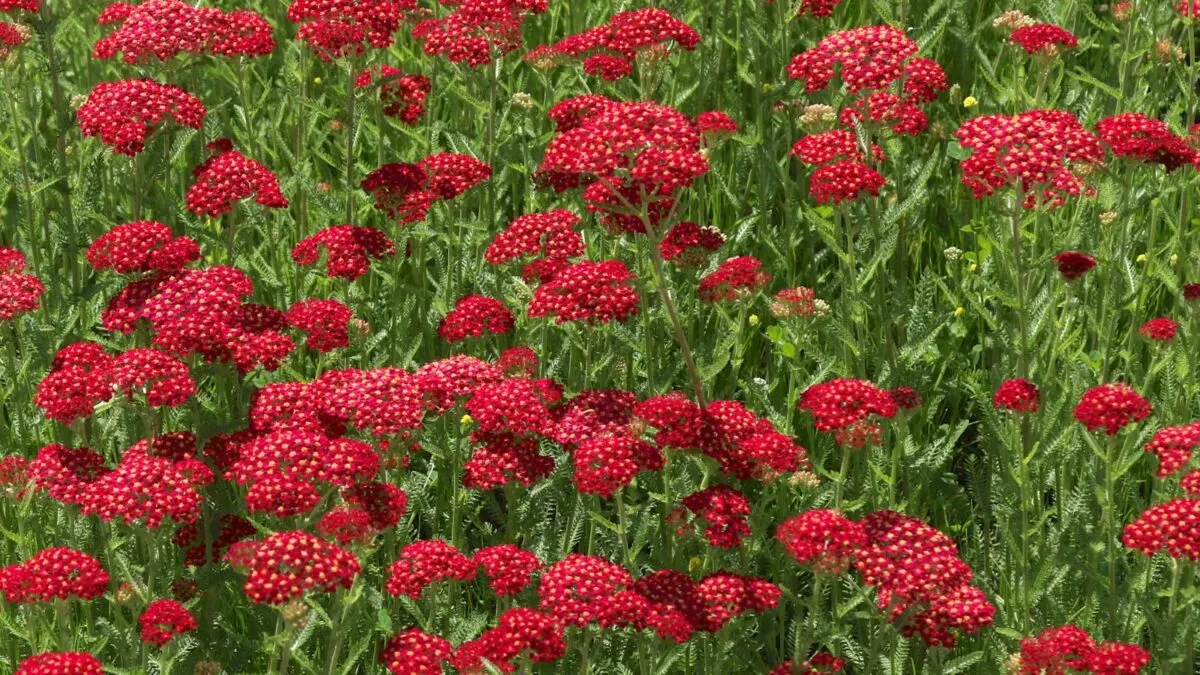Everyone knows that roses are red (and other colors, too), but so many other flowers come in crimson shades, too! The list below celebrates 11 perennial red flowers that bring vivid color to the garden year after year.

1. Wild columbine (Aquilegia canadensis)

In spring, wild columbine produces unique, drooping flowers on tall stalks, with bright red spurs jutting upward and sunny yellow centers facing down. Its distinctive foliage makes an attractive groundcover, with deeply lobed leaves that somewhat resemble a rabbit’s paw.
This native of eastern North American woodlands thrives in part shade and moist soil rich in organic matter. It grows best in USDA zones 3-8.
2. Cardinal flower (Lobelia cardinalis)

The tubular, lipstick-red blossoms of cardinal flower bloom in terminal spikes from late summer into fall, attracting hummingbirds and butterflies. A tall plant, it can reach up to four or five feet high. The shiny, lanceolate leaves have serrated edges and grow from branched stems.
This native wildflower thrives in zones 3-9. It appreciates full sun to part shade and rich, moist to wet soil.
3. Peony (Paeonia hybrids)

Known for their large, showy, ruffled flowers, peonies come in a range of colors, including bold shades of red. This woody to herbaceous perennial grows one to three feet tall, sometimes needing extra support to keep the heavy blossoms erect.
Peonies like deep, well-drained, fertile soils in full sun to part shade and good air circulation. They can be grown in zones 3-8.
4. Crimson beebalm (Monarda didyma)

Well loved by bees, butterflies, and hummingbirds, crimson beebalm produces tight terminal clusters of scarlet tubular flowers in summer. Its leaves give off a minty fragrance when crushed. Crimson beebalm grows up to four feet tall and readily spreads via underground stolons.
A native of eastern North America, crimson beebalm is hardy in zones 4-9. It thrives in moist soils with good drainage in full sun but will tolerate light shade.
5. Coneflower (Echinacea spp.)

Though coneflower is perhaps best known for having pinkish-purple or yellow petals, some cultivars come in striking red hues. This upright, clumping perennial grows up to three feet tall and feeds butterflies with its nectar and songbirds with its seeds.
Tolerant of drought, heat, light shade, poor soil, and rocky conditions, coneflower thrives in full sun and moist to dry, well-drained soil. It grows best in zones 3-8.
6. Scarlet sage (Salvia coccinea)

Scarlet sage blooms continuously throughout the summer, attracting hummingbirds and butterflies with its loose whorls of tubular flowers. It grows one to three feet tall and often self-sows, making it great for mass plantings, borders, and cottage gardens.
Native to the southern US and Mexico, scarlet sage is winter hardy in zones 8-10. It thrives in sandy, fertile soil and full sun to part shade.
7. Yarrow (Achillea millefolium)

The soft, ferny foliage of yarrow provides a beautiful backdrop to its flat-topped clusters of tiny flowers, which range in color from white to crimson. It has a tendency to spread aggressively in ideal conditions, making it a good choice for a ground cover, naturalized areas, or even a lawn alternative.
Yarrow likes well-drained soil in full sun. It thrives in zones 3-9.
8. Dahlia (Dahila spp.)

Though rather high maintenance, dahlias are worth it for their showy late-season blooms. The numerous cultivars vary widely in bloom shape, color, and size, and the plants can grow anywhere from one to six feet tall.
Dahlias thrive in zones 7-10 in full to part sun and moist, fertile, well-drained soil. To overwinter them in colder regions, dig up the tubers in autumn, dry them, and store them in dry sand or vermiculite at 35 to 45 degrees F.
9. Astilbe (Astilbe x arendsii)

Some varieties of astilbe bloom all season, from late spring into fall. Tall stalks hold the feathery plumes of tiny flowers above attractive, mounded foliage that ranges from dark green to bronze. These lovely plants grow well in borders, containers, woodland gardens, and along ponds and streams.
Astilbe prefers moist, rich, well-drained soil in part shade, though it will tolerate full sun with constant moisture. It thrives in zones 3-9.
10. Oriental poppy (Papaver orientale)

Loved for its large, papery, cup-shaped flowers, oriental poppy blooms in midsummer for a vibrant display before dying back. A rosette of gray-green, finely divided foliage reemerges in fall and persists through winter, finally growing upward again in spring.
Oriental poppy appreciates good drainage and full sun. It does not tolerate heat or humidity well and grows best in zones 3-7.
11. Red hibiscus (Hibiscus coccineus)

Red hibiscus blooms in late summer and early fall, producing large, striking flowers up to six inches across. This stunning plant grows an impressive six to eight feet tall, perfect for back borders, and often attracts butterflies, hummingbirds, and other pollinators.
This native of marshes and swamps of the southeastern US prefers moist, occasionally wet soil in full to part sun. It thrives in zones 5-9.
Do You Have a Shady Garden? Try One of These 5 Red Shade Perennials

A low light garden doesn’t mean you can’t have beautiful flowers. Add a few of these striking red perennials that don’t mind the shade.
Add a Pop of Color with 11 Showy Annual Red Flowers

While perennials certainly have their benefits, the quickest way to get some show-stopping crimson blooms into your garden is to plant annuals.
